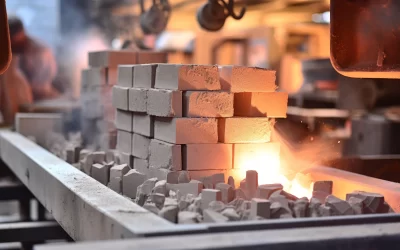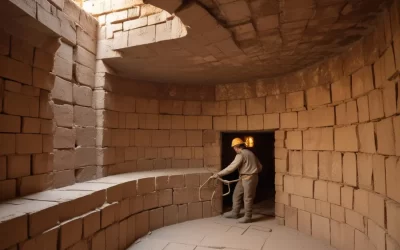Refined and specialized refractory materials stand as the backbone of various industrial sectors due to their exceptional properties. As the demand for refractory materials continues to trend upward, the metallurgical industry remains a key player in their utilization and advancement.
According to recent studies, the demand for refractory materials has emerged to new heights because of flourishing metal production and is projected to reach 27.4 million by 2025.
Now, let’s unravel the pivotal importance of refractory materials for the metallurgical industry and explore what the future holds. Read on to learn more!
A Significance of Refractory Materials for the Metallurgical Industry
Refractory materials play a crucial role in the metallurgical industry – where extreme temperatures and harsh conditions are commonly encountered. These specialized refractory materials are designed to withstand high temperatures, corrosive environments, and mechanical stress, making them essential for the production of metals and alloys.
As they can maintain their chemical and physical strength at temperatures above 500°C. They are often used to line smelting furnaces, kilns, reactors, and other vessels that demand extremely high temperatures.
Refractoriness is mainly tested with a refractory cone sample to ensure they maintain their integrity when subjected to high temperatures during the steel melting process, without melting or softening.
However, to ensure the efficient production of metal, it is crucial to consider the right materials with uncompromised quality. Ganeshas is a leading refractory manufacturer in India, fulfilling the end-to-end needs of various industries including metallurgical.
5 Common Refractory Materials Used in the Metallurgical Industry
The following are the widely used refractory materials in the metallurgical industry. Have a quick look and find the right one as per your application needs.
Alumina Refractory Bricks
As the name indicates, these bricks are mostly made of alumina (Al2O3) and are well-known for their durability in high temperatures and abrasive surroundings. Alumina refractory bricks are available in a range of forms, including low alumina bricks, high alumina bricks, and so on, depending on the alumina concentration. These bricks are utilized as protective linings in metallurgical applications such as kilns, furnaces, and other high-temperature machinery.
Fireclay Bricks
Fireclay bricks are made of a powerful blend of high alumina and fireclay, giving them great thermal shock resistance at high temperatures. Fireclay bricks, with their outstanding heat resistance and chemical stability, are essential for the fabrication of lining materials for all kinds of high-temperature equipment in metallurgical processes.
Silica Bricks
Silica bricks are manufactured from minerals that exist naturally, such as quartz stones, silica gravel conglomerates, and novaculite. They are widely utilized as refractory materials in the metallurgical industry for furnace materials such as the hot stove of a big blast furnace and the top layer of an acid open-hearth furnace. Despite this, silica bricks come in a variety of grades, including common grades that are acceptable for the iron and steel industries. On the other side, super silica grades are used in the glass sector.
Refractory Castable
Refractory castables are composed of refractory aggregates, binders, and other additives and can be utilized either directly or with water or other liquid. Refractory castables, like industrial refractory materials, are used to protect high-temperature equipment from chemical attacks and endure extreme temperatures. Craftsmen used them to line furnaces, kilns, reactors, and other structures.
Refractory Mortar
The metallurgical industry relies heavily on refractory mortar, which is used to build and maintain the linings of high-temperature blast furnaces and machinery. Its principal role is to bond refractory bricks or forms together, creating a strong and heat-resistant wall capable of withstanding the severe temperatures experienced in metallurgical processes.
The Future of Refractory Materials for Metallurgical Industry
The future of refractory materials for the metallurgical industry holds promise for innovation and advancement in the near future. Several trends are expected to shape the future landscape of refractory materials in metallurgy:
→ Manufacturing advanced refractory materials with improved properties.
→ Advanced integration of digitalization and smart technologies to enhance industrial application performance.
→ Recycling refractory materials to promote sustainable practices.
→ Creating customized refractory solutions to meet industry-specific requirements.
→ Maximizing the potential of the moulding procedure to enhance the efficiency of refractory in the monolithic form.
→ The incorporation of additive manufacturing methods such as nanotechnology, 3D printing, and other result-driven machines.
Take Away
Refractory materials have become the backbone of many industries, with metallurgy topping the list of those that rely heavily on refractories. Whether you require refractory castables, fireclay bricks, silica bricks, alumina bricks, or other specialized refractories for the metallurgical industry, Ganeshas Refractory has your back.
As a leading refractory manufacturer in India, we have years of experience providing a diverse range of refractory materials that can even be tailored to specific industrial application requirements.
Our team is dedicated to manufacturing refractory materials using advanced machines and techniques, as well as ensuring that end products are thoroughly tested for quality before shipping. Get in touch with our team for further details.




